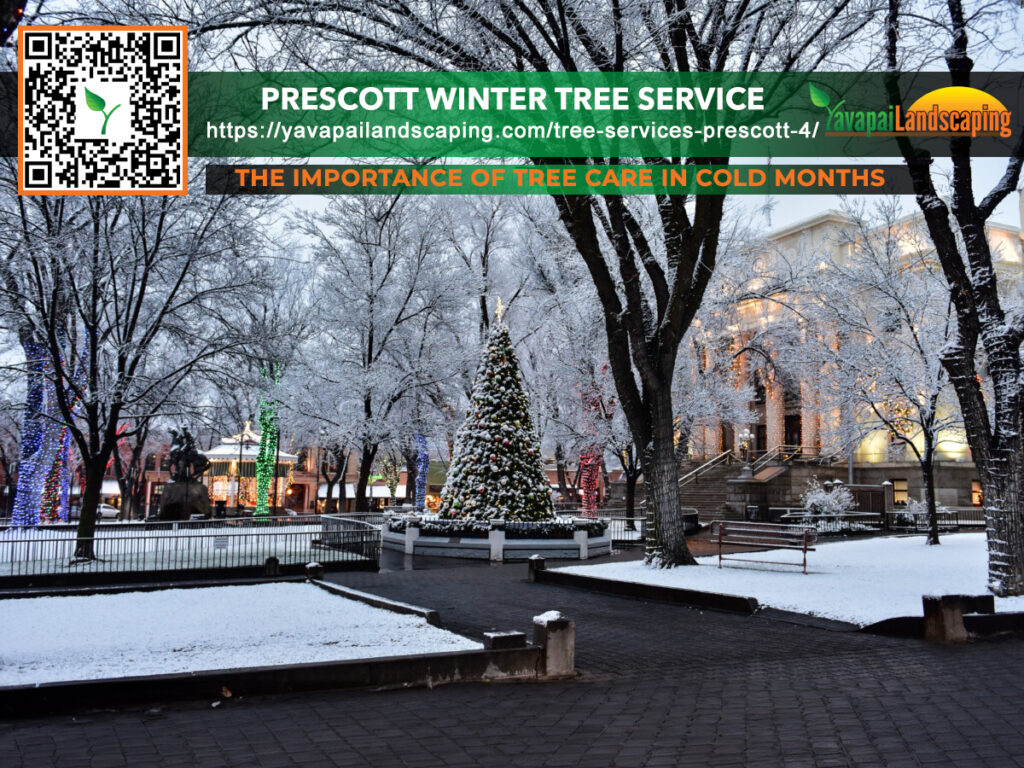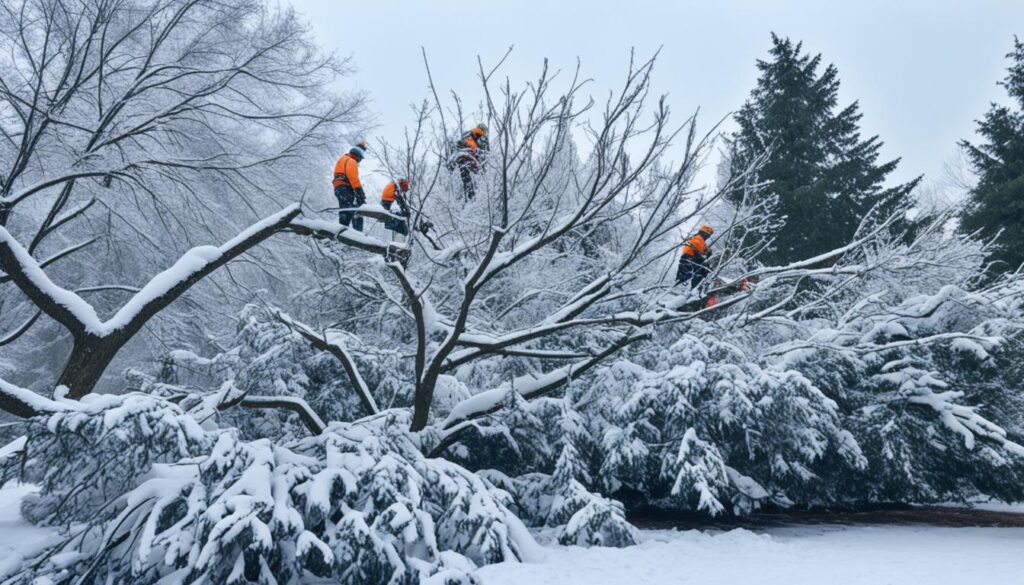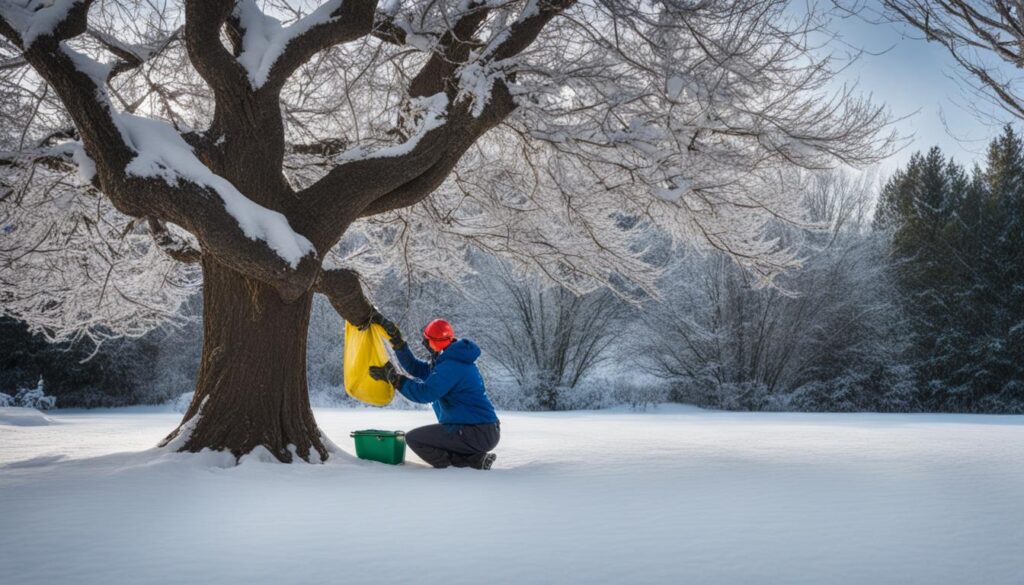
In Prescott, AZ, Winter Tree Service is crucial to have a comprehensive tree service plan to ensure the health and well-being of your trees during the cold season. Winter weather conditions in Prescott can pose unique challenges to tree health, but with proper care and maintenance, you can protect your trees from potential damage and promote their longevity. Consider availing yourself of Winter Tree Service in Prescott to safeguard your trees this winter season.
When developing a winter tree service plan, several key elements should be included:
Key Takeaways:
- Tree pruning in winter promotes optimal tree health and growth.
- Winter tree fertilization provides essential nourishment and protection.
- Professional winter tree inspections help detect diseases and hazards early.
- Implementing winter tree protection measures safeguards trees from extreme conditions.
- Regular winter tree maintenance ensures their well-being throughout the season.
Tree Pruning in Winter for Optimal Health and Growth
One of the key components of a comprehensive winter tree service plan is tree pruning. Pruning your trees during the winter months not only enhances their aesthetics but also promotes optimal health and growth. Winter tree pruning is a beneficial practice that helps maintain the overall well-being of your trees, ensuring their longevity and vitality.
Why Winter Tree Pruning Matters

Pruning during the winter season offers several advantages for your trees. Firstly, with the leaves gone, it becomes easier to assess the tree’s structure and identify any potential issues. By removing dead or damaged branches, you can prevent diseases from spreading and minimize the risk of weak branches falling during winter storms.
Moreover, winter pruning stimulates tree growth by redirecting energy from dormant branches to healthy ones, resulting in fuller foliage and improved overall shape. It also encourages the development of strong branch structures, as pruning during the dormant season reduces the likelihood of excessive new growth that may lead to structural weaknesses. Dig deeper into How Does Winter Tree Help with Pruning Techniques Improve Tree Health.
Effective Techniques for Winter Tree Pruning
When pruning your trees during winter, certain techniques can optimize the results:
- Thinning: This method involves selectively removing branches to improve airflow and sunlight penetration, reducing the risk of disease development and promoting tree health.
- Pruning for structure: By removing crossing, rubbing, or weakly attached branches, you can enhance the tree’s overall structure and prevent future hazards.
- Crown reduction: When necessary, reducing the size of the tree’s crown can help maintain its shape and prevent the branches from becoming too large and vulnerable to damage during winter storms.
- Deadwooding: Removing dead, diseased, or damaged branches not only improves aesthetics but also eliminates potential sources of tree decay and pest infestation.
Remember, winter tree pruning should be done with caution, keeping in mind the specific needs of each tree species. It is advisable to consult with a professional arborist who can provide expert guidance on the appropriate pruning techniques for your trees.
Winter Tree Fertilization to Nourish and Protect
Another essential element of a comprehensive tree service plan is tree fertilization. Proper nourishment during the winter months is crucial to strengthen tree roots, improve resistance to diseases and pests, and protect against harsh winter conditions. Fertilizing your trees in winter ensures their health and enhances their ability to thrive when spring arrives. Here are some key benefits of winter tree fertilization:
- Enhanced root development: By providing essential nutrients during winter, fertilization promotes robust root growth, enabling trees to better withstand environmental stressors.
- Increased disease resistance: Winter tree fertilization strengthens the tree’s immune system, making it less susceptible to diseases and infections that commonly occur during the colder months.
- Improved overall tree health: The nutritional boost offered by winter fertilization supports the tree’s overall well-being, leading to vibrant foliage, stronger branches, and better overall growth.
- Increased resilience to pests: Well-nourished trees are less attractive to pests, reducing the chances of infestations and minimizing damage caused by insects.
Effective Winter Tree Fertilization Guidelines
While winter tree fertilization provides numerous benefits, it is essential to follow proper guidelines to ensure optimal results. Consider the following tips when fertilizing your trees in winter:
- Select the right fertilizer: Choose a slow-release or controlled-release fertilizer specifically formulated for winter use.
- Apply at the correct time: Fertilize your trees in late fall or early winter before the ground freezes.
- Measure accurately: Follow the manufacturer’s instructions to determine the appropriate amount of fertilizer to apply based on the size and type of tree.
- Avoid overfertilization: Applying excessive amounts of fertilizer can harm the tree and lead to nutrient imbalances.
- Distribute evenly: Spread the fertilizer evenly in a circular pattern around the base of the tree, avoiding direct contact with the trunk.
- Water adequately: After applying fertilizer, water the area thoroughly to help the nutrients penetrate the soil and reach the tree’s roots.
By following these guidelines, you can effectively fertilize your trees during winter, ensuring their health and protection.

Professional Winter Tree Inspection for Early Detection
Regular tree inspection is vital during the winter months to prevent diseases, identify potential hazards, and address issues early on. Conducting thorough inspections ensures the health and safety of your trees. In this section, we will discuss the importance of professional winter tree inspections, what to look for, and how to take appropriate action based on the findings.
Importance of Winter Tree Inspections
Winter poses unique challenges for tree health, making inspections even more crucial during this season. By conducting regular inspections, you can:
- Identify signs of disease or pest infestations before they worsen.
- Assess the structural integrity of trees, identifying potential hazards such as weak branches or damaged limbs.
- Prevent winter storms from causing significant damage by proactively addressing weak or vulnerable areas.
- Ensure trees are in optimal health, promoting their overall resilience and longevity.
What to Look for During Winter Tree Inspections
During winter tree inspections, pay close attention to the following:
- Visible signs of disease or pest infestations, such as discoloration, unusual growth, or pest activity.
- Cracks, splits, or cavities in the trunk or branches, may indicate structural weakness.
- Dead or decaying branches that could pose a hazard if they were to fall.
- Unusual leaning or tilting of the tree may indicate root issues or instability.
It is essential to conduct inspections for both young and mature trees as well as those located near structures or high-traffic areas. Educate yourself on What Are the Risks of Not Removing Critical Tree Limbs in Winter in Prescott.
Taking Action Based on Inspection Findings
Once you have completed a winter tree inspection, it is important to take appropriate action based on your findings:
- Address any signs of disease or pest infestations promptly by consulting with a certified arborist.
- Prune or remove weak or hazardous branches to prevent potential damage during winter storms.
- If a tree poses a threat to people or structures, consider consulting with a professional for further evaluation and potential removal.
- Implement preventive measures, such as cabling or bracing, to support structurally weakened trees.
By prioritizing professional winter tree inspections, you can ensure the health and safety of your trees, prevent disease and hazards, and maintain the beauty of your landscape throughout the winter season.

Winter Tree Protection Measures for Extreme Conditions
During the winter months, your trees face numerous challenges from extreme weather conditions, such as heavy snowfall and freezing temperatures. To ensure the longevity and health of your trees, it is essential to implement effective winter tree protection measures.
One crucial method of winter tree protection is mulching. Applying a layer of organic mulch around the base of your trees helps insulate the soil and retain moisture, preventing freeze-thaw cycles that can damage the roots. Additionally, mulching acts as a barrier against weed growth and helps regulate soil temperature.
Another valuable practice is wrapping your trees. By carefully wrapping the trunks with burlap or tree wrap, you create a protective shield against harsh winter winds and extreme cold. This helps prevent winter burn and damage to the bark, ensuring the tree’s overall well-being.
Strategic pruning is also a key component of winter tree protection. By removing dead, diseased, or structurally weak branches, you reduce the risk of limbs breaking under the weight of snow or ice. This proactive approach minimizes potential hazards and promotes the tree’s health and safety.
Yavapai Landscaping Prescott offers free quotes for Prescott and its surrounding areas for landscaping and tree services. This includes tree removal, trimming, stump grinding, land clearing, storm clean up, and emergency tree service.
